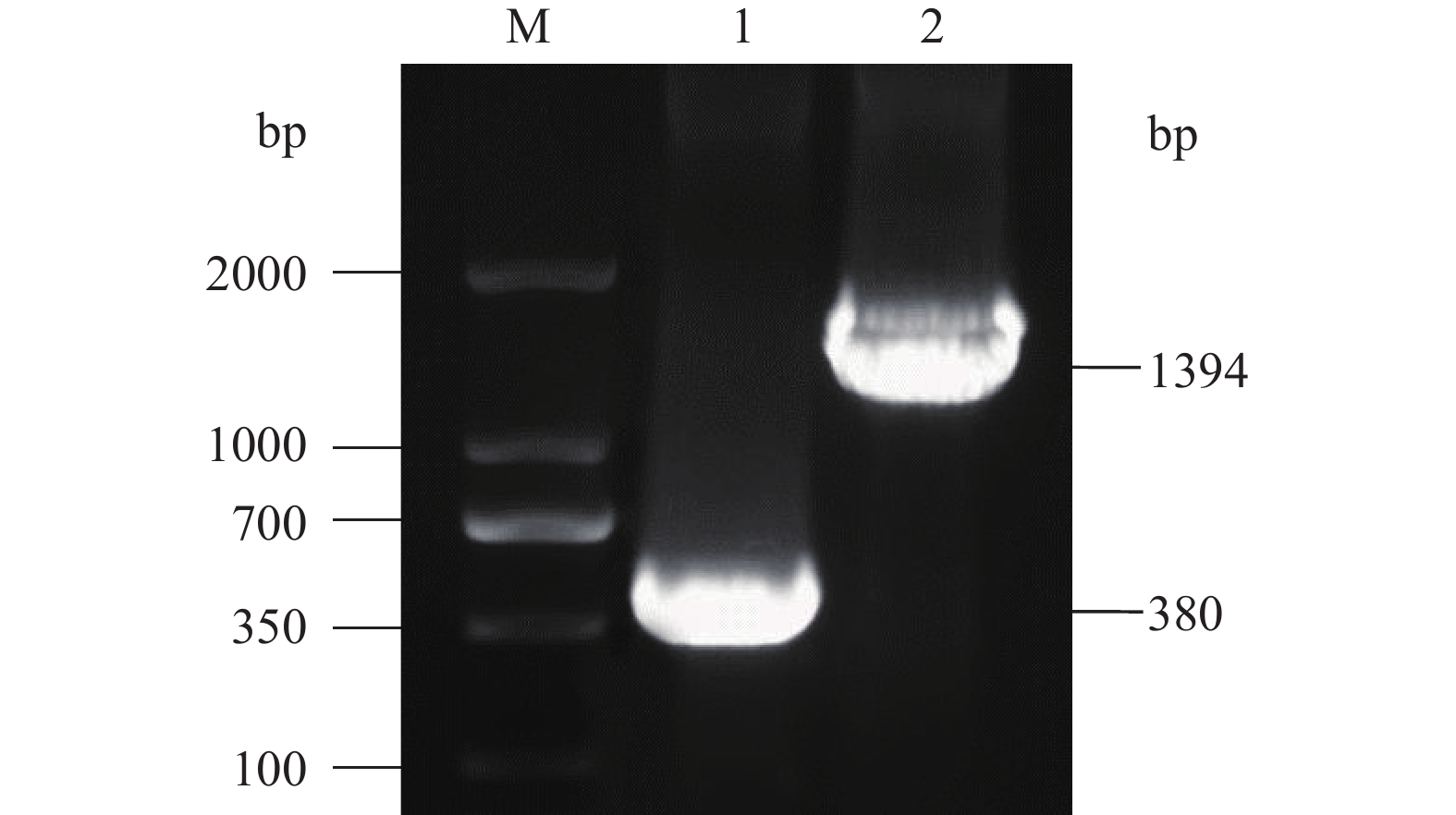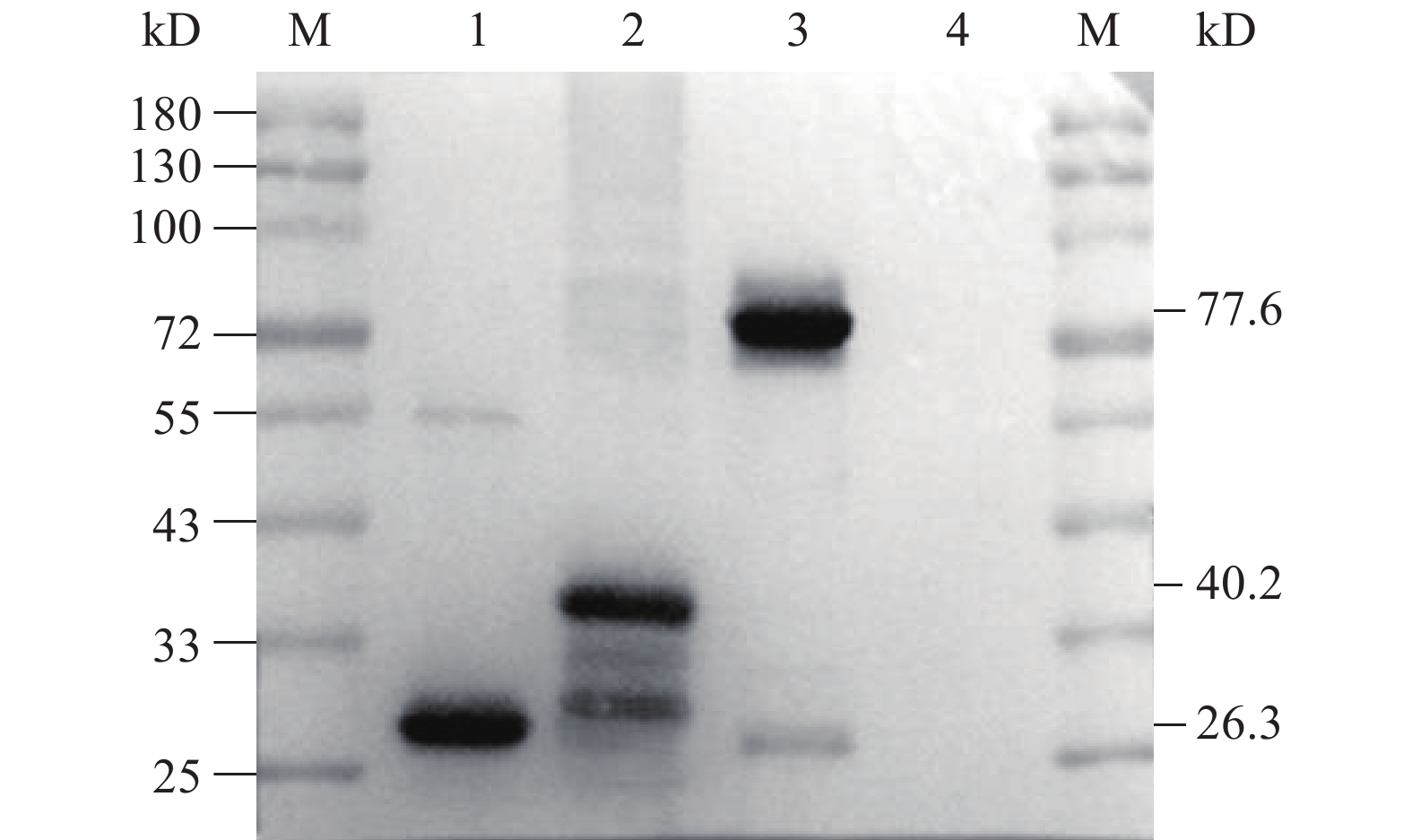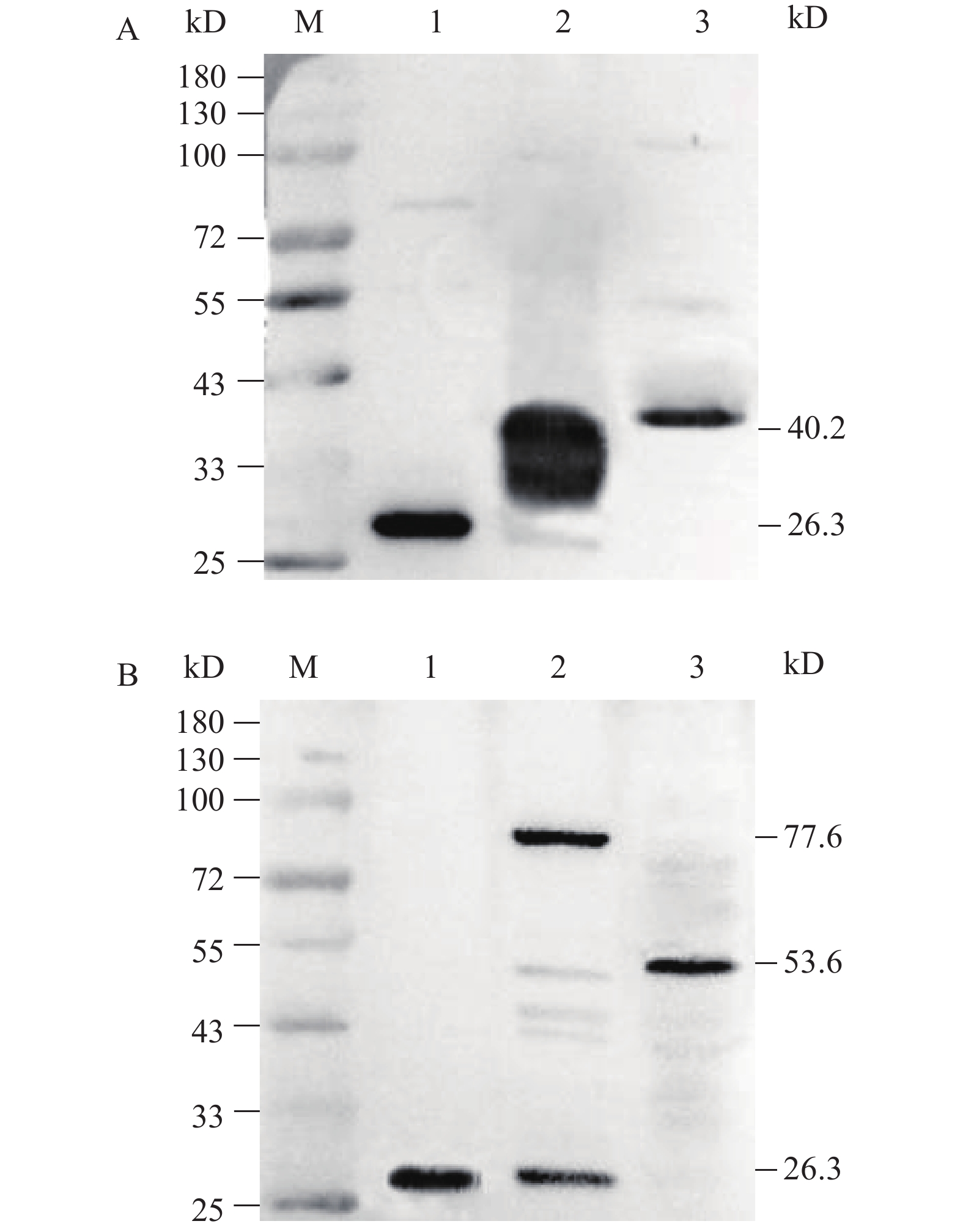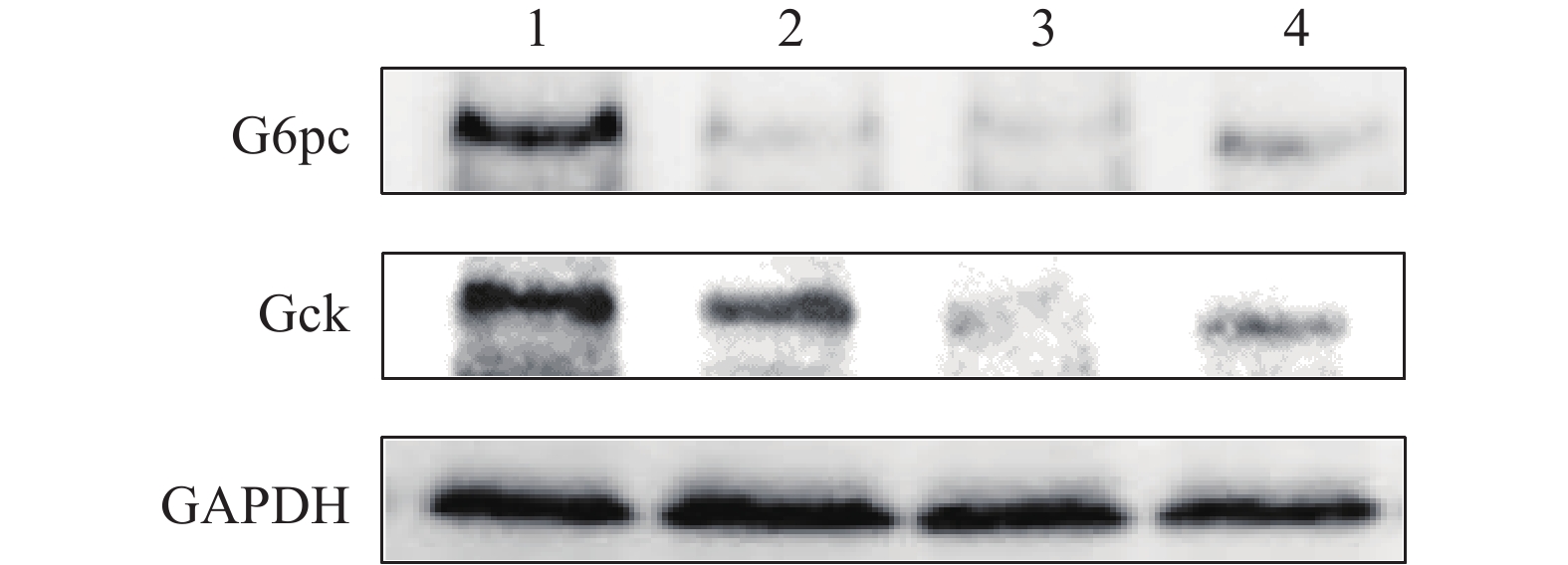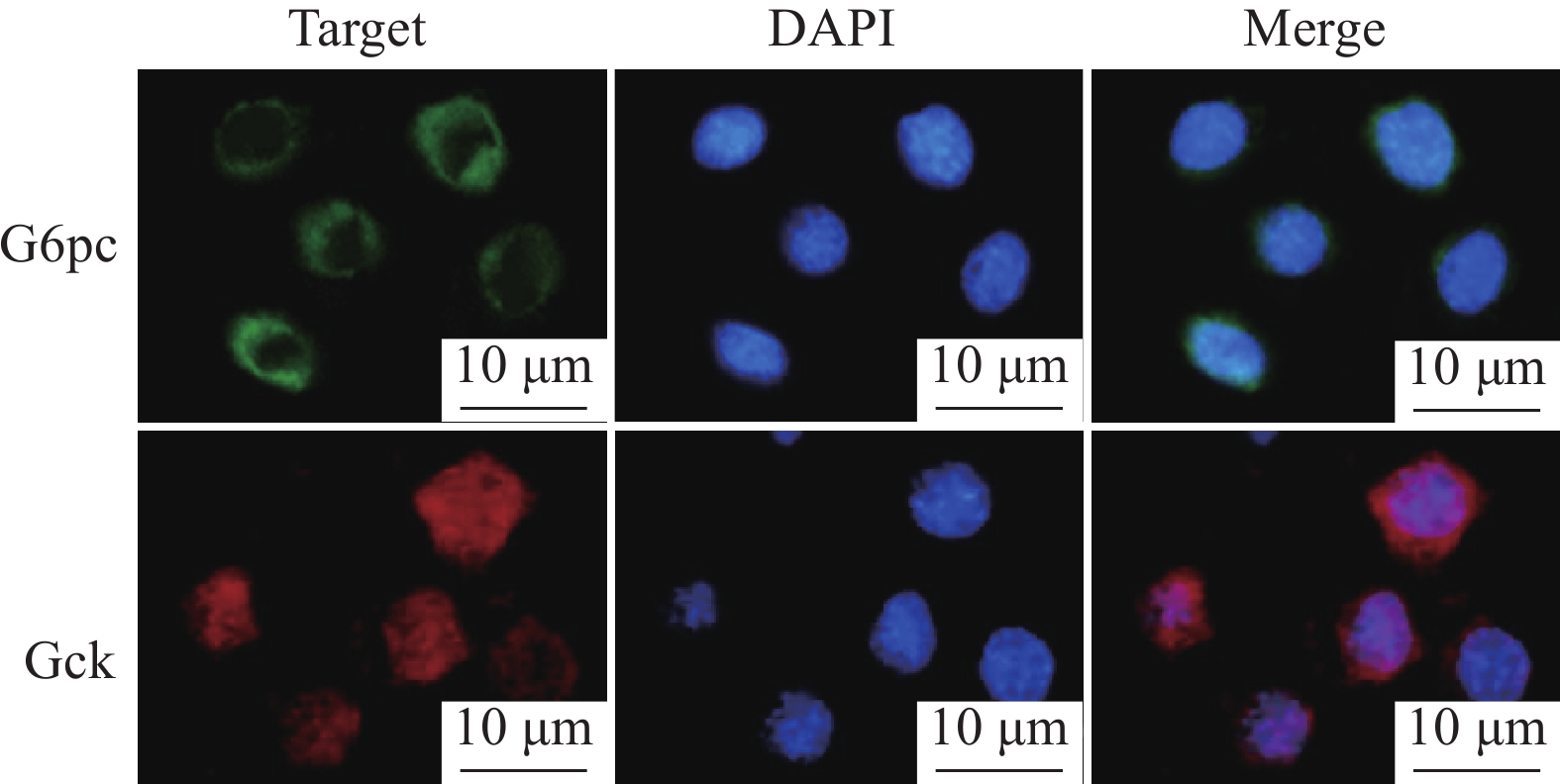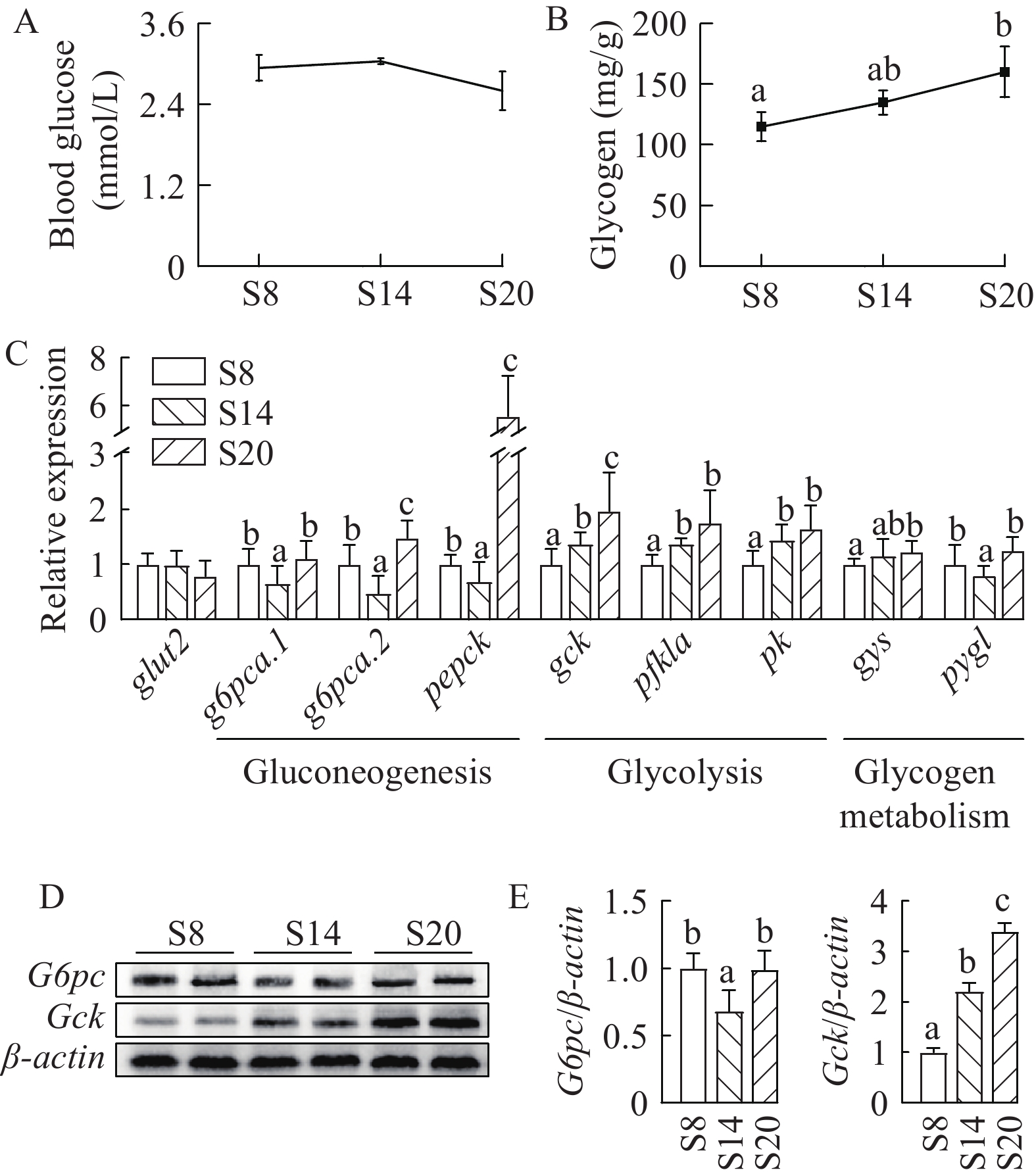PROKARYOTIC EXPRESSION, ANTIBODY PREPARATION, AND REGULATION BY DIETARY STARCH LEVELS OF G6PC AND GCK IN MICROPTERUS SALMOIDES
-
摘要:
为深入研究营养因子调控大口黑鲈(Micropterus salmoides)葡萄糖稳态的分子机制, 研究成功克隆并构建了大口黑鲈葡萄糖-6-磷酸酶催化亚基(G6pc)和葡萄糖激酶(Gck)截短序列的重组质粒载体, 转化至Escherichia coli Rosetta感受态细胞并以1 mmol/L IPTG (异丙基-β-D-硫代半乳糖苷)、16℃诱导表达过夜, 在细胞破碎后的上清中得到了大量表达。通过GST-tag亲和层析的方法纯化得到高纯度的G6pc和Gck截短重组蛋白后, 将其分别与弗氏佐剂乳化成免疫原, 免疫KM小鼠5次, 成功制备具有高特异性和高效价的多克隆抗体(G6pc和Gck抗体的效价分别大于1﹕3000和1﹕10000)。Westen blot检测发现大口黑鲈G6pc和Gck蛋白主要分布在肝脏中, 免疫荧光染色显示G6pc的阳性信号定位于细胞核周围, 而Gck的阳性信号散布整个细胞。在8周养殖实验结束后, 随饲料淀粉水平以6%的梯度从8%增加到20%, 大口黑鲈肝脏中糖酵解和糖原合成关键酶编码基因的表达及Gck水平逐渐升高, 但糖异生和糖原分解关键酶编码基因的表达及G6pc水平仅在14%淀粉水平时被抑制, 意味着在高淀粉水平(20%)下大口黑鲈肝脏中葡萄糖-G6P间的相互转化发生了无效循环。综上所述, 研究成功制备了大口黑鲈G6pc和Gck特异性识别的多克隆抗体, 探明了饲料淀粉水平对其表达的影响, 为深入研究G6pc和Gck在大口黑鲈葡萄糖稳态维持过程中的重要作用奠定了基础。
Abstract:The dysregulation of glucose-G6P (glucose-6-phosphate) interconversion is thought to be an important reason for the low glucose tolerance of carnivorous fish. However, it remains unclear if this phenomenon applies to largemouth bass (Micropterus salmoides, LMB). To investigate the regulatory mechanism of glucose homeostasis influenced by nutritional factors in LMB, we cloned and constructed recombinant plasmid vectors containing truncated sequences of glucose-6-phosphatase catalytic subunit (g6pc) and glucokinase (gck). These recombinant plasmid vectors were transformed into Escherichia coli Rosetta receptor cells and successfully expressed using 1 mmol/L IPTG (isopropyl-β-D-thiogalactopyranoside) induction overnight at 16℃. Following the lysis receptor cells, truncated G6pc, and Gck recombinant proteins were purified by GST-tag affinity chromatography from the supernatants. The purified recombinant proteins were emulsified with Freund's adjuvant to create immunogens, and immunized to KM mice for five times. G6pc and Gck polyclonal antibodies with high specificity were successfully prepared with titers exceeding 1﹕3000 and 1﹕10000, respectively. Western blot analysis showed that both G6pc and Gck in LMB were mainly distributed in the liver. Immunofluorescent staining indicated that the G6pc positive signals were localized around the nucleus, whereas Gck positive signals spread throughout the hepatocytes. After an 8-weeks feeding trial, the results showed that Gck level and the expression of genes involved in glycolysis and glycogenesis in the liver of LMB increased gradually with dietary starch levels rising from 8% to 20% in 6% increments. Conversely, G6pc levels and the expression of genes involved in gluconeogenesis and glycogenolysis were only down-regulated at 14% starch. These results suggested that a high starch diet (20%) could induce a futile cycle of glucose-G6P interconversion in the liver of LMB. In summary, specific polyclonal antibodies of G6pc and Gck were successfully prepared in LMB, and the regulation of their expression by dietary starch levels was evaluated in this study. This research lays the foundation for further elucidating the roles of G6pc and Gck in the glucose homeostasis of LMB.
-
Keywords:
- G6Pase /
- Glucokinase /
- Prokaryotic expression /
- Polyclonal antibody /
- Micropterus salmoides
-
-
图 1 大口黑鲈G6pc和Gck蛋白的理化性质和三级结构分析
A. G6pc; B. Gck; 截短后蛋白的氨基酸序列由黑色方框标出, 三级结构由深色表示
Figure 1. Physicochemical properties and structural analysis of deduced G6pc and Gck in largemouth bass
A. G6pc; B. Gck; Black boxes indicate amino acid sequences of truncated proteins; Tertiary structures are indicated by dark colors
图 3 G6pc和Gck重组蛋白表达和纯化产物的SDS-PAGE分析
A. G6pc重组蛋白; B. Gck重组蛋白; M. 蛋白质分子量标准; 1. 未诱导空质粒; 2. 诱导后空质粒; 3. 未诱导截短重组质粒; 4. 诱导后截短重组质粒; 5. 破菌后沉淀; 6. 破菌后上清; 7. 纯化后重组蛋白
Figure 3. SDS-PAGE analysis of G6pc and Gck recombinant protein expression and purified products
A. recombinant G6pc; B. recombinant Gck. M. protein marker; 1. uninduced empty plasmid; 2: induced empty plasmid; 3. uninduced truncated recombinant plasmid; 4. induced truncated recombinant plasmid; 5. precipitation after bacterial fragmentation; 6. supernatant after bacterial fragmentation; 7. purified target recombinant protein
图 9 饲料淀粉水平对大口黑鲈糖代谢的影响
A. 血糖水平; B. 肝糖原含量(n=3); C. 基因表达(n=3); D. 蛋白质免疫印迹(n=3); E. 蛋白质免疫印迹量化分析; 数据以平均值±SD 表示(n=3); 不同字母代表不同处理之间存在显著差异
Figure 9. Effects of dietary starch level on glycometabolism in LMB
A. Blood glucose; B. Hepatic glycogen content (n=3); C. Gene expression (n=3); D. Western blot (n=3); E. Quantitative analysis of Western blot (n=3); Data are presented as means±SD (n=3); Different letters indicate significant differences among treatments
表 1 实验饲料配方及营养组成(干物质)
Table 1 Formulation and nutritional composition of the experimental diets (dry matter basis)
原料Ingredient (%) S8 S14 S20 木薯淀粉Cassava starch 7.00 14.00 19.00 微晶纤维素Microcrystalline cellulose 6.85 6.00 1.69 沸石粉Zeolite powder 6.84 1.69 0.00 其他Others1 79.3 79.3 79.3 营养组成Proximate composition (Analyzed, % dry matter) 水分Moisture 7.93 9.85 9.64 粗蛋白Crude protein 49.1 49.3 49.8 粗脂肪Crude lipid 11.4 11.6 11.6 淀粉Starch 8.13 14.1 20.1 灰分Ash 18.3 13.6 12.0 注: 1鱼粉. 34.0; 豆粕. 7.50; 谷朊粉. 15.0; 鸡肉粉. 13.0; 鱼油. 2.40; 豆油. 2.40; 磷酸二氢钙. 2.00; 多维多矿. 2.00; 维生素C磷酸酯. 0.20; 蛋氨酸. 0.25; 氯化胆碱. 0.50; 防腐剂. 0.01; 抗氧化剂. 0.05Note: 1 Fish meal. 34.0; soybean meal. 7.50; wheat gluten. 15.0; chicken meal. 13.0; fish oil. 2.40; soybean oil. 2.40; monocalcium phosphate. 2.00; vitamin and mineral premix. 2.00; VC phosphate. 0.20; methionine. 0.25; choline chloride. 0.50; antiseptic. 0.01; antioxidant. 0.05 表 2 引物序列
Table 2 Primer sequences
名称Name 引物序列Primer sequences (5′—3′) 退火TM (℃) 产物Product (bp) 截短表达载体构建Truncated expression vector construction pGEX-G6pc-F CGGGATCCATGAACGCTATAATGGACACCATGC 60.0 380 pGEX-G6pc-R CCGCTCGAGTTACATAGCATGTCCAGAGGGGCTG pGEX-Gck-F CGGGATCCATGCCGTGTGTCTCCTCTCAT 60.0 1394 pGEX-Gck-R CCGCTCGAGTTACTCCGACTGGATGAAGGTG 实时荧光定量PCR Quantitative Real-time PCR g6pca.1-F ACTTCCTTCGCTGTTGGCTT 60.5 150 g6pca.1-R ACCCATGTTACGCAGTAGGC g6pca.2-F TTCCCGCTTTGGTTTCACCT 61.0 195 g6pca.2-R AGTCTCACAGGTCATGGGGT gck-F CTCGCTCTGCTCGTATGT 55.0 207 gck-R CTCCCTTCCTCCGACTG pepck-F ACGTCAACTGGTTCCGCAAGA 65.0 142 pepck-R TGAGGCAGGTAGCCCACAGC pfkla-F TGCGTGGAGGGAGTTTTG 62.0 176 pfkla-R CTTGTGTCCGTGAGCGAG pk-F CGCTCTGCCCAGGATGTCAAAG 65.0 142 pk-R CAACCATCACGCCGTCACTCTC gys-F TTATTCTCTCTCGCTCCCG 62.0 150 gys-R TCTGCCTATCACCTGCCTC pygl-F AACCAACGGCATCACTC 58.5 144 pygl-R AGGGCAGCATTATCAACA glut2-F CTGGAAGAGATGAGGAGAG 57.5 155 glut2-R GAGCGGATAAACAGAATG eef1a1-F GTTGCTGCTGGTGTTGGTGAG 60.0 156 eef1a1-R GAAACGCTTCTGGCTGTAAGG 注: g6pc. 葡萄糖-6-磷酸酶催化亚基; gck. 葡萄糖激酶; pepck. 磷酸烯醇丙酮酸羧激酶; pfk. 磷酸果糖激酶; pk. 丙酮酸激酶; gys. 糖原合酶; pygl. 糖原磷酸化酶; glut. 葡萄糖转运蛋白; eef. 真核翻译延伸因子Note: g6pc. glucose-6-phosphatase catalytic; gck. glucokinase; pepck. phosphoenolpyruvate carboxykinase; pfk. phosphofructokinase; pk. pyruvate kinase; gys. glycogen synthase; pygl. phosphorylase glycogen, liver; glut. glucose transporter; eef. eukaryotic translation elongation factor -
[1] Hiriart M, Velasco M, Larqué C, et al. Metabolic syndrome and ionic channels in pancreatic beta cells [J]. Vitamins and Hormones, 2014(95): 87-114.
[2] Nordlie R C, Foster J D, Lange A J. Regulation of glucose production by the liver [J]. Annual Review of Nutrition, 1999, 19(1): 379-406. doi: 10.1146/annurev.nutr.19.1.379
[3] Li M V, Chen W, Harmancey R N, et al. Glucose-6-phosphate mediates activation of the carbohydrate responsive binding protein (ChREBP) [J]. Biochemical and Biophysical Research Communications, 2010, 395(3): 395-400. doi: 10.1016/j.bbrc.2010.04.028
[4] Panserat S, Rideau N, Polakof S. Nutritional regulation of glucokinase: a cross-species story [J]. Nutrition Research Reviews, 2014, 27(1): 21-47. doi: 10.1017/S0954422414000018
[5] Sternisha S M, Miller B G. Molecular and cellular regulation of human glucokinase [J]. Archives of Biochemistry and Biophysics, 2019(663): 199-213.
[6] van Schaftingen E, Gerin I. The glucose-6-phosphatase system [J]. The Biochemical Journal, 2002, 362(3): 513-532. doi: 10.1042/bj3620513
[7] Hutton J C, O’Brien R M. Glucose-6-phosphatase catalytic subunit gene family [J]. The Journal of Biological Chemistry, 2009, 284(43): 29241-29245. doi: 10.1074/jbc.R109.025544
[8] NRC (National Research Council). Nutrient Requirements of Fish and Shrimp [M]. National Academy Press, Washington, DC, 2011.
[9] Panserat S, Capilla E, Gutierrez J, et al. Glucokinase is highly induced and glucose-6-phosphatase poorly repressed in liver of rainbow trout (Oncorhynchus mykiss) by a single meal with glucose[J]. Comparative Biochemistry and Physiology Part B: Biochemistry & Molecular Biology, 2001, 128 (2): 275-283.
[10] Skiba-Cassy S, Panserat S, Larquier M, et al. Apparent low ability of liver and muscle to adapt to variation of dietary carbohydrate: protein ratio in rainbow trout (Oncorhynchus mykiss) [J]. The British Journal of Nutrition, 2013, 109(8): 1359-1372. doi: 10.1017/S0007114512003352
[11] Wang K W, Liu Q Q, Zhu J, et al. Transcriptome analysis provides insights into the molecular mechanism of liver inflammation and apoptosis in juvenile largemouth bass Micropterus salmoides fed low protein high starch diets [J]. Comparative Biochemistry and Physiology Part D: Genomics & Proteomics, 2023(45): 101047.
[12] Ma H J, Mou M M, Pu D C, et al. Effect of dietary starch level on growth, metabolism enzyme and oxidative status of juvenile largemouth bass, Micropterus salmoides [J]. Aquaculture, 2019(498): 482-487. doi: 10.1016/j.aquaculture.2018.07.039
[13] Liu Q Q, Xia R, Deng X, et al. Effects of dietary starch and metformin levels on the growth performance, body composition, hepatic glycolipid metabolism, and liver histology of juvenile largemouth bass Micropterus salmoides [J]. Aquaculture, 2023(573): 739582. doi: 10.1016/j.aquaculture.2023.739582
[14] Lin S M, Shi C M, Mu M M, et al. Effect of high dietary starch levels on growth, hepatic glucose metabolism, oxidative status and immune response of juvenile largemouth bass, Micropterus salmoides [J]. Fish & Shellfish Immunology, 2018(78): 121-126.
[15] Li S, Sang C, Turchini G M, et al. Starch in aquafeeds: the benefits of a high amylose to amylopectin ratio and resistant starch content in diets for the carnivorous fish, largemouth bass (Micropterus salmoides) [J]. The British Journal of Nutrition, 2020, 124(11): 1145-1155. doi: 10.1017/S0007114520002214
[16] Liu Y J, Liu N, Wang A, et al. Resveratrol inclusion alleviated high dietary carbohydrate induced glycogen deposition and immune response of largemouth bass, Micropterus salmoides [J]. The British Journal of Nutrition, 2022, 127(2): 165-176. doi: 10.1017/S0007114521000544
[17] Xia R, Liu H K, Liu X F, et al. Molecular cloning and tissue distribution of glucokinase and glucose-6-phosphatase catalytic subunit paralogs in largemouth bass Micropterus salmoides: Regulation by dietary starch levels and a glucose load [J]. Comparative Biochemistry and Physiology Part A: Molecular & Integrative Physiology, 2024(287): 111523.
[18] 王康伟. 饲料蛋白和淀粉水平对大口黑鲈生长、饲料利用和肝脏健康的影响 [D]. 重庆: 西南大学, 2023: 18-19.] Wang K W. Effect of protein and starch levels in diet on growth, feed utilization and liver health of largemouth bass Micropterus salmoides [D]. Chongqing: Southwest University, 2023: 18-19. [
[19] Ma D M, Fan J M, Tian Y Y, et al. Selection of reference genes for quantitative real-time PCR normalisation in largemouth bass Micropterus salmoides fed on alternative diets [J]. Journal of Fish Biology, 2019, 95(2): 393-400. doi: 10.1111/jfb.13991
[20] Livak K J, Schmittgen T D, Analysis of relative gene expression data using real-time quantitative PCR and the 2−ΔΔCT method [J]. Methods, 2001(25): 402-408.
[21] Tsuji Y. Transmembrane protein western blotting: Impact of sample preparation on detection of SLC11A2 (DMT1) and SLC40A1 (ferroportin) [J]. PLoS One, 2020, 15(7): e0235563. doi: 10.1371/journal.pone.0235563
[22] 唐青蓝, 许庆忠, 张礼林, 等. pGEX-4T-3-MFGF21表达载体的构建、表达与纯化 [J]. 生物技术, 2014, 24(2): 18-24.] Tang Q L, Xu Q Z, Zhang L L, et al. Construction, expression and purification of pGEX-4T-3-MFGF21 [J]. Biotechnology, 2014, 24(2): 18-24. [
[23] 王辉, 刘林, 阮记明, 等. 草鱼Pim-1基因克隆、组织表达及多克隆抗体的制备 [J]. 江西农业大学学报, 2022, 44(3): 670-678.] Wang H, Liu L, Ruan J M, et al. Molecular cloning, tissue expression and preparation of polyclonal antibody of Pim-1 in grass carp (Ctenopharygodon idella) [J]. Acta Agriculturae Universitatis Jiangxiensis, 2022, 44(3): 670-678. [
[24] 罗国玲, 牛金中, 黄瑜, 等. 尼罗罗非鱼Galectin-3基因的原核表达与条件优化 [J]. 广东海洋大学学报, 2019, 39(4): 35-41.] Luo G L, Niu J Z, Huang Y, et al. Prokaryotic expression and condition optimization of Galectin-3 gene in Oreochromis [J]. Journal of Guangdong Ocean University, 2019, 39(4): 35-41. [
[25] 张涓, 陈思思, 何玉慧, 等. 团头鲂β-防御素1基因cDNA的克隆、序列分析及表达特征 [J]. 华中农业大学学报, 2015, 34(3): 97-103.] Zhang J, Chen S S, He Y H, et al. Molecular cloning, sequence analysis and expression pattern of β-defesin 1 in Megalobrama amblycephala [J]. Journal of Huazhong Agricultural University, 2015, 34(3): 97-103. [
[26] 包义风, 应莲芳, 蒋琳. 包涵体蛋白复性技术研究进展 [J]. 微生物学免疫学进展, 2012, 40(2): 84-88.] Bao Y F, Ying L F, Jiang L. Research progress in renaturation of inclusion body protein [J]. Progress in Microbio logy and Immunology, 2012, 40(2): 84-88. [
[27] 严馨蕊, 鲍永利, 董学斌, 等. 抗重组GST单克隆抗体的制备及其在融合蛋白纯化中的应用 [J]. 细胞与分子免疫学杂志, 2001, 17(4): 365-367.] Yan X R, Bao Y L, Dong X B, et al. Preparation of monoclonal antibody against recombinant GST and its application in purification of GST fusion protein [J]. Journal of Cellular and Molecular Immunology, 2001, 17(4): 365-367. [
[28] 靳换, 李逸, 姜楠, 等. 与PRRSV nsp11互作的宿主细胞蛋白鉴定及生物信息学分析 [J]. 微生物学通报, 2017, 44(12): 2856-2870.] Jin H, Li Y, Jiang N, et al. Identification and bioinformatics analysis of host cellular proteins interacting with PRRSV nsp11 [J]. Microbiology China, 2017, 44(12): 2856-2870. [
[29] Printz R L, Magnuson M A, Granner D K. Mammalian glucokinase [J]. Annual Review of Nutrition, 1993, 13(1): 463-496. doi: 10.1146/annurev.nu.13.070193.002335
[30] Guionie O, Clottes E, Stafford K, et al. Identification and characterisation of a new human glucose-6-phosphatase isoform [J]. FEBS Letters, 2003, 551(1-3): 159-164. doi: 10.1016/S0014-5793(03)00903-7
[31] Zhang L, Jain M K. Circadian regulation of cardiac metabolism [J]. The Journal of Clinical Investigation, 2021, 131(15): e148276. doi: 10.1172/JCI148276
[32] Taj S, Li X J, Zhou Q C, et al. Insulin-mediated glycemic responses and glucose homeostasis in black sea bream (Acanthopagrus schlegelii) fed different carbohydrate sources [J]. Aquaculture, 2021, 540: 736726. doi: 10.1016/j.aquaculture.2021.736726
[33] 苟仕潘, 陈乃松, 徐祥泰, 等. 饲料中可消化淀粉对大口黑鲈生长、体组成和非特异性免疫指标的影响 [J]. 水产学报, 2015, 39(10): 1499-1510.] Gou S P, Chen N S, Xu X T, et al. Effects of dietary digestible starch levels on growth performance, body composition, and non-specific immunological index of largemouth bass (Micropterus salmoides) [J]. Journal of Fisheries of China, 2015, 39(10): 1499-1510. [
[34] Marandel L, Seiliez I, Véron V, et al. New insights into the nutritional regulation of gluconeogenesis in carnivorous rainbow trout (Oncorhynchus mykiss): a gene duplication trail [J]. Physiological Genomics, 2015, 47(7): 253-263. doi: 10.1152/physiolgenomics.00026.2015
[35] Yang M X, Deng K Y, Pan M Z, et al. Molecular adaptations of glucose and lipid metabolism to different levels of dietary carbohydrates in juvenile Japanese flounder Paralichthys olivaceus [J]. Aquaculture Nutrition, 2020, 26(2): 516-527. doi: 10.1111/anu.13013
-
期刊类型引用(40)
1. 周旭东,李其林,罗俊,殷德勇,李尚科. 人工湿地净化技术在微污染河流生态修复中的应用研究. 环境科学与管理. 2024(09): 78-82 .  百度学术
百度学术
2. 陈尧,倪金雷,汤文艳,章昱斌. 人工湿地对封闭水体净化的研究. 中国新技术新产品. 2023(05): 135-137 .  百度学术
百度学术
3. 刘岚昕,于素晗,李娜,王赫,冷雪飞,包震宇,李崇. 内电解-沉水植物-微生物耦合体系处理黑臭水体效能及机制研究. 环境污染与防治. 2023(06): 796-804 .  百度学术
百度学术
4. 陈亮东,江达均,关歆,杨金兰,谷阳光. 华南地区尾水治理设施养殖场水质综合评价. 淡水渔业. 2023(04): 106-112 .  百度学术
百度学术
5. 朱欣乐,陈思宇,杨正,刘晶,黄元昊,彭英杰,兰时乐. 一株氨化芽孢细菌的分离鉴定及氨化培养基优化. 湖南生态科学学报. 2022(01): 34-43 .  百度学术
百度学术
6. 杨玲丽,马琳,刘伟,褚一凡,谭启洋,周巧红,吴振斌,贺锋. 铜和磺胺甲唑复合污染下人工湿地对禽畜养殖尾水的处理效果. 水生生物学报. 2022(10): 1484-1493+1592 .  本站查看
本站查看
7. 戴天杰,魏攀龙,潘杨,司壮壮,王静. 苏州市景观水体表观污染类型识别及特征指标筛选. 水资源保护. 2021(02): 141-147 .  百度学术
百度学术
8. 赵诣. 有机磷灭蚊剂投放浓度和时间对水体总磷的影响. 水资源保护. 2021(04): 117-120+126 .  百度学术
百度学术
9. 王翔,朱召军,张金菊,张瑜倩,李鸿,张红川. 异位组合人工湿地用于河流水质净化. 中国给水排水. 2021(14): 137-141 .  百度学术
百度学术
10. 潘超群,胡齐福,牛会星,黄立波,张元赏,葛春亮. 曝气生物膜反应器处理受污染河道水体实验研究. 水处理技术. 2020(10): 124-127 .  百度学术
百度学术
11. 莫斌,余谦. 桂林乌金河黑臭水体河道末端砾间接触氧化和人工快滤联合治理技术研究. 大众科技. 2020(07): 23-26 .  百度学术
百度学术
12. 刘国臣,王福浩,梁家成,佘宗莲. 不同水位垂直流人工湿地中植物及微生物特征. 中国海洋大学学报(自然科学版). 2019(02): 98-105 .  百度学术
百度学术
13. 王红,阮爱东,徐洁. 太湖氨化功能菌群的分布及其有机氮降解条件. 河南科学. 2019(03): 439-446 .  百度学术
百度学术
14. 房金秀,谢文霞,朱玉玺,沈雷,马玉坤,李佳,姜智绘,李叙勇,赵洪涛. 合流制面源污染传输过程与污染源解析. 环境科学. 2019(06): 2705-2714 .  百度学术
百度学术
15. 王红,徐洁,阮爱东,徐耀飞,韦琪,李思言. 两株氨化菌的筛选及降解效果初步研究. 地球环境学报. 2019(05): 487-495 .  百度学术
百度学术
16. 谭小川,肖婧,洪雅,覃建军. 3种不同填料对城市黑臭水体的修复效果比较. 环境科学与技术. 2018(S1): 178-183 .  百度学术
百度学术
17. 宁梓洁,王鑫. 黑臭水体治理技术研究进展. 环境工程. 2018(08): 26-29+73 .  百度学术
百度学术
18. 柏珊珊,韩超,韩帮军,姚杰,韩雅红. 哈尔滨信义沟水环境污染现状及治理研究. 哈尔滨商业大学学报(自然科学版). 2018(03): 307-310 .  百度学术
百度学术
19. 盛建海,韩涛,王骥腾,郑普强,杨敏,徐含颖. 源自生物絮团产絮凝剂的异养硝化-好氧反硝化菌xt1的鉴定及其脱氮特性. 海洋与湖沼. 2018(02): 375-383 .  百度学术
百度学术
20. 万博阳,王全金,戚晓波. 多级人工湿地-塘组合系统去除污染物研究. 长江科学院院报. 2017(03): 25-29 .  百度学术
百度学术
21. 王昱,王浩. 不同生态修复手段对硝态氮和铵态氮脱除机制的影响. 环境科技. 2017(05): 1-5 .  百度学术
百度学术
22. 刘亚樵,韩学军,谭好臣,陆洪省. 一株高效氨氮降解菌的分离及其氨氮去除能力分析. 山东科技大学学报(自然科学版). 2017(02): 70-75 .  百度学术
百度学术
23. 蔺凌云,尹文林,潘晓艺,袁雪梅,姚嘉赟,徐洋,王超,沈锦玉. 自然微生物挂膜处理水产养殖废水的效果及微生物群落分析. 水生生物学报. 2017(06): 1327-1335 .  本站查看
本站查看
24. 付新喜,吴晓芙,陈永华,奚成业,周鑫. 季节变化对组合湿地污水处理系统净化力的影响. 中南林业科技大学学报. 2017(09): 124-128 .  百度学术
百度学术
25. 魏佳明,崔丽娟,李伟,雷茵茹,于菁菁,秦鹏,穆泳林,梁钊瑞. 表流湿地细菌群落结构特征. 环境科学. 2016(11): 4357-4365 .  百度学术
百度学术
26. 王全金,万博阳,戚晓波. 污水停留时间对多级人工湿地塘组合系统除氮的影响. 科学技术与工程. 2016(05): 245-249 .  百度学术
百度学术
27. 刘志伟,周美修,宋俊玲,郭志伟. 复合垂直流人工湿地污染物去除特征及微生物群落多样性分析. 环境工程. 2014(06): 38-42 .  百度学术
百度学术
28. 翁益松,刘朝飞,陈钺. PKA人工湿地技术在生活污水处理中的试验研究. 环境污染与防治. 2014(06): 47-50 .  百度学术
百度学术
29. 杜彩艳,段宗颜,雷宝坤,胡万里,陈拾华,金桂梅. 我国人工湿地处理污染水体技术研究进展(英文). Agricultural Science & Technology. 2014(02): 310-320 .  百度学术
百度学术
30. 朱文涛,王永向,刘龙龙. 复合垂直流人工湿地污染物去除特点及微生物群落多样性PCR-TGGE分析. 上海环境科学. 2014(02): 73-77+83 .  百度学术
百度学术
31. 郑佳佳,张小平,胡彩虹,李卫芬. 斯氏假单胞菌对草鱼养殖水体水质的调控作用. 渔业现代化. 2013(03): 5-9 .  百度学术
百度学术
32. 陈石,陈翔,李月,王吟,吴凡. 可生物降解改性填料的制备及其对养殖废水处理效果研究. 渔业现代化. 2013(05): 18-22+68 .  百度学术
百度学术
33. 赵艳,李锋民,王昊云,李扬,王震宇. 不同结构好氧/厌氧潜流人工湿地微生物群落代谢特性. 环境科学学报. 2012(02): 299-307 .  百度学术
百度学术
34. 董金凯,贺锋,肖蕾,黄丹萍,吴振斌. 人工湿地生态系统服务综合评价研究. 水生生物学报. 2012(01): 109-118 .  本站查看
本站查看
35. 郑佳佳,沈涛,傅罗琴,邓斌,李卫芬. 一株硝化反硝化菌的筛选鉴定及反硝化特性研究. 水生生物学报. 2012(01): 161-167 .  本站查看
本站查看
36. 郑喜春,郭晓军,姚娜,曹晓璐,李潞滨,朱宝成. 反硝化芽孢杆菌的筛选鉴定及反硝化特性. 生态学杂志. 2012(06): 1447-1452 .  百度学术
百度学术
37. 盛辛辛,赵凤岐,曹谨玲,刘青. 不同级配基质垂直流人工湿地对中水的净化效果分析. 山西农业大学学报(自然科学版). 2012(01): 63-69 .  百度学术
百度学术
38. 赵艳,李锋民,王昊云,李扬,张明全,王震宇. 好氧/厌氧潜流湿地微生物多样性与净化能力的关系. 环境科学学报. 2011(11): 2423-2431 .  百度学术
百度学术
39. 周元清,李秀珍,李淑英,唐莹莹,辛在军,贾悦. 不同类型人工湿地微生物群落的研究进展. 生态学杂志. 2011(06): 1251-1257 .  百度学术
百度学术
40. 王娟,戴习林,宋增福,潘迎捷,张庆华. 一株氨化细菌的分离、鉴定及氨氮降解能力的初步分析. 水生生物学报. 2010(06): 1198-1201 .  本站查看
本站查看
其他类型引用(40)



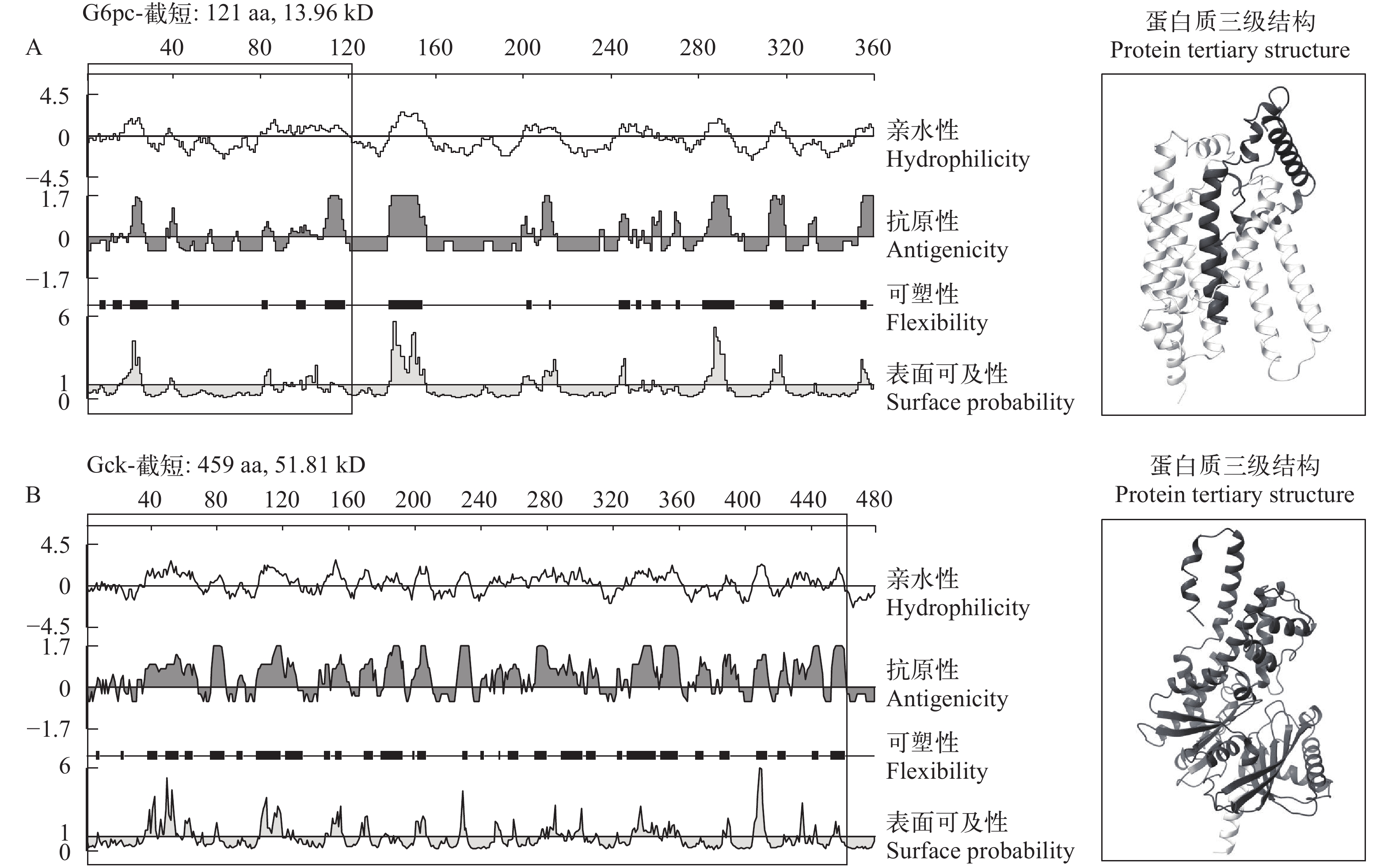
 下载:
下载:
